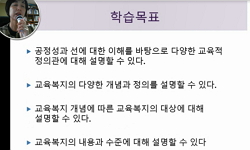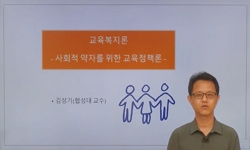The purpose of this study was to investigate influence of perceived helpfulness of education welfare program on school happiness of students from low-income families. For the purpose of this study, surveyed data from 155 students in the middle school ...
http://chineseinput.net/에서 pinyin(병음)방식으로 중국어를 변환할 수 있습니다.
변환된 중국어를 복사하여 사용하시면 됩니다.
- 中文 을 입력하시려면 zhongwen을 입력하시고 space를누르시면됩니다.
- 北京 을 입력하시려면 beijing을 입력하시고 space를 누르시면 됩니다.
교육복지 대상학생이 인식한 교육복지사업의 도움정도가 학교행복감에 미치는 영향에 관한 연구 = The Influence of Perceived Helpfulness of Education Welfare Program on School Happiness of Students from Low-Income Families
한글로보기https://www.riss.kr/link?id=T13515788
- 저자
-
발행사항
서울 : 숭실대학교 사회복지대학원, 2014
-
학위논문사항
학위논문(석사) -- 숭실대학교 사회복지대학원 사회복지대학원 , 상담복지전공(사원) , 2014. 8
-
발행연도
2014
-
작성언어
한국어
- 주제어
-
발행국(도시)
서울
-
형태사항
p. 26cm
-
일반주기명
숭실대학교 논문은 저작권에 의해 보호받습니다.
The Influence of Perceived Helpfulness of Education Welfare Program on School Happiness of Students from Low-Income Families
지도교수:노혜련
참고문헌: p. - 소장기관
-
0
상세조회 -
0
다운로드
부가정보
다국어 초록 (Multilingual Abstract)
The purpose of this study was to investigate influence of perceived helpfulness of education welfare program on school happiness of students from low-income families. For the purpose of this study, surveyed data from 155 students in the middle school which performed the education welfare service around Seoul area were analyzed. The main outcomes from the analysis of the survey data are as follows.
First, study participants reported to have above average school happiness. Also participants evaluate the area of psychological emotion is the most helpful, on the contrary to this, they evaluate the area of learning is not helpful.
Second, analyses showed that there were significant differences in level of school happiness of adolescent according to their general characteristics, such as grade level and situation of the home.
Third, analyzing school happiness difference in level of education welfare program, group of above average in level of education welfare program shows higher level of school happiness than group of below average. Also, analyzing school happiness' sub-factor of education welfare program, it indicated that group of above average accordance to level of degree of helpfulness in education welfare program showed higher self-efficacy, interpersonal relationship, joy of learning activity and environmental satisfaction figure than group of below the average.
Fourth, in order to answer the major study question on how the education welfare program impact on school happiness of low-income adolescents, the multiple regression analysis was conducted. Result of the regression analysis showed that the students think that they are helped, school happiness showed high. And the result indicated among sub-factors in education welfare program, the more students perceive level of the area of cultural experience and the area of psychological emotion, the more higher school happiness.
Finally, The result of which sub-factors in level of helpfulness in education welfare program affects on sub-factors in school happiness,
perceptions about the degree of cultural experience and psychological emotion affect on self-efficacy, joy of learning activity and positive influence on environmental satisfaction. Also it is indicated perception in level of helpfulness of psychological emotion affects on teacher relationship as a positive effect.
Based on these results, the practical implications of this study are as follows.
First, the education welfare program affect the school happiness of low-income adolescents. Raised the need to provide measures that can be activated in the education welfare programs for the low-income adolescents.
Secondly, the area of psychological emotion and the area of cultural experience showed a high degree of school happiness rather than another area. This is able to be a media which heals emotional instability that appears in adolescence. Hence, it needs to be grope for a way how increase area of psychological emotion though using more in-depth qualitative research way. Also more helpful program development considering about adolescents growth characteristics is needed.
Third, it is necessary that we look into the reasons why degree of assistance in an area of learning which inspires education welfare program to support more asset than other area is low and focus on process-oriented intervention out of result-oriented intervention.
Fourth, we need to approach to different perspectives by seizing what students truly needs rather than emphasizing a material support in the areas of welfare.
국문 초록 (Abstract)
본 연구는 교육복지 대상학생이 인식한 교육복지사업의 도움정도가 학교행복감에 어떠한 영향을 미치는지를 확인하기 위한 목적으로 수행되었다. 연구를 위해 서울시교육청 산하 11개 교육...
본 연구는 교육복지 대상학생이 인식한 교육복지사업의 도움정도가 학교행복감에 어떠한 영향을 미치는지를 확인하기 위한 목적으로 수행되었다. 연구를 위해 서울시교육청 산하 11개 교육지원청 소속학교 중 교육복지사업을 시행하고 있는 8개교의 중학교 2학년, 3학년 학생 155명을 대상으로 조사를 실시하였으며, 조사된 자료를 이용하여 분석한 연구의 주요결과는 다음과 같다.
첫째, 연구에 참여한 대상학생이 인식한 학교행복감 수준과 교육복지사업의 도움정도를 살펴본 결과, 보통수준의 학교행복감을 나타냈고, 심리정서 도움 정도를 가장 높게 평가한 반면 학습 도움정도는 가장 낮게 평가했다.
둘째, 연구 대상자의 일반적인 특성에 따른 학교행복감 수준의 차이를 살펴본 결과, 성적이 높고, 경제적으로 잘 산다고 인식한 학생의 학교 행복감 수준이 더 높은 것으로 나타났다.
셋째, 교육복지사업의 도움정도에 따른 학교행복감 수준의 차이를 분석한 결과, 교육복지사업의 도움정도가 평균 이상인 집단이 평균 이하인 집단보다 학교행복감 수준이 더 높게 나타났다. 또한 교육복지사업의 도움정도에 따른 학교행복감의 하위 요인들을 분석한 결과 교육복지사업의 도움정도가 평균이상인 집단이 평균 미만인 집단보다 자기효능감, 교사관계, 친구관계, 학습활동즐거움, 환경만족에서 유의미하게 더 높은 결과가 나타났다.
넷째, 교육복지사업의 도움정도가 학교행복감에 영향을 미치는지를 파악하기 위해 회귀분석을 실시한 결과, 교육복지사업이 도움이 됐다고 인식할수록 학교행복감이 높은 결과가 나왔으며, 교육복지사업 도움정도의 하위요인(학습, 문화·체험, 심리·정서, 복지·지원)중에서 문화체험 도움정도와 심리정서 도움정도를 높게 인식할수록 학교행복감이 높은 것으로 나타났다.
다섯째, 교육복지사업 도움정도의 하위요인이 학교행복감의 하위요인(자기효능감, 교사관계, 친구관계, 심리적 안정, 학습활동의 즐거움, 환경만족)에 미치는 영향에 대해 알아본 결과, 문화체험 도움정도와 심리정서 도움정도에 대한 인식이 자기효능감, 학습활동의 즐거움, 환경만족에정적인 영향을 미치는 것으로 나타났고, 심리정서 도움정도에 대한 인식은 교사관계에 정적인 영향을 미치는 것으로 나타났다.
본 연구결과의 실천적 함의는 다음과 같다. 첫째, 교육복지사업의 도움정도에 대한 인식이 대상학생의 학교행복감에 유의한 영향을 미치므로 대상학생이 교육복지사업에 흥미와 관심을 가지고 적극적으로 참여할 수 있도록 그들에게 도움이 되는 다양한 프로그램을 개발하는 방안을 마련할 필요가 있다. 특히 문화체험 도움정도와 심리정서 도움정도를 높게 인식할수록 학교행복감이 높은 것으로 나타났는데 이는 또래활동을 중요시하는 청소년의 발달 시기적 특성을 반영한 문화체험 프로그램을 더욱더 많이 개발할 필요성을 시사한다. 또한 심리정서영역의 경우 청소년기에 나타나는 정서적 불안정감을 달래주는 매개체가 된다고 볼 수 있으므로 지금보다 좀 더 심도 있는 질적 연구를 통해 도움정도를 높일 수 있는 더 나은 방법이 무엇인지 모색해볼 필요가 있다.
둘째, 본 연구결과 학생들은 현재 교육복지사업에서 다른 영역에 비해 더 많은 예산을 지원하도록 독려하고 있는 학습영역의 도움정도는 상대적으로 낮게 인식하는 것으로 나타났다. 이러한 결과는 학교에서 학습 관련 프로그램을 진행할 때 학생들이 스스로 학습하고 흥미를 느낄 수 있게 한 것인지 등에 대한 의문을 갖게 한다. 따라서 학습영역에서도 학생들의 개별 욕구와 능력에 따라 차별화된 프로그램을 개발해 대상학생의 학업능력 향상에 진정으로 도움이 될 수 있어야 할 것이다. 아울러복지지원의 도움정도에 대한 인식도 학교행복감에 유의미한 영향을 미치지 못하는 것으로 나타났는데, 학생들에게 필요한 자원을 효율적이고도 효과적으로 제공함으로써 학생들의 욕구에 적절하게 부응하는 교육복지 실천이 이루어져야 할 것이다.
목차 (Table of Contents)
- 목 차
- 국문초록 ⅵ
- 영문초록 ⅸ
- 목 차
- 국문초록 ⅵ
- 영문초록 ⅸ
- 제 1 장 서론 1
- 1.1 연구의 필요성 1
- 1.2 연구의 목적 6
- 제 2 장 문헌고찰 7
- 2.1 학교행복감에 대한 이해 7
- 2.1.1 행복감의 정의 7
- 2.1.2 학교행복감의 개념 및 구성요인 8
- 2.1.2.1 자기효능감 10
- 2.1.2.2 대인관계 10
- 2.1.2.3 심리적 안정 11
- 2.1.2.4 학습활동의 즐거움 11
- 2.1.2.5 환경만족 12
- 2.2 교육복지의 개념 13
- 2.3 교육복지 사업의 이해 15
- 2.3.1 교육복지사업의 개념과 현황 15
- 2.3.2 교육복지사업의 추진배경과 의의 17
- 2.3.3 교육복지사업의 대상과 프로그램 내용 18
- 2.4 선행연구 고찰 23
- 2.4.1 교육복지사업의 효과 24
- 제 3 장 연구방법 27
- 3.1 연구모형 27
- 3.2 연구문제 28
- 3.3 조사대상과 자료수집 29
- 3.4 변수의 정의와 측정도구 29
- 3.4.1 종속변수: 학교행복감 29
- 3.4.2 독립변수: 교육복지사업의 도움정도 31
- 3.4.3 통제변수: 일반적 특성 31
- 3.5 자료의 분석방법 32
- 제 4 장 연구결과 33
- 4.1 연구대상자의 일반적 특성 33
- 4.1.1 일반적 특성 33
- 4.2 주요 연속 변수의 기술통계 34
- 4.2.1 종속변수 : 학교행복감 34
- 4.2.2 독립변수 : 교육복지사업의 도움정도 35
- 4.3 일반적 특성에 따른 학교행복감 수준의 차이 36
- 4.4 교육복지사업의 도움정도에 따른 학교행복감 수준의 차이 40
- 4.5 교육복지사업의 도움정도가 대상학생의 학교행복감에 미치는
- 영향 40
- 4.5.1 주요 변수 간의 상관관계 40
- 4.5.2 다중공선성 확인 42
- 4.5.3 대상학생의 학교행복감에 영향을 미치는 요인 42
- 제 5 장 결론과 제언 51
- 5.1 연구결과 요약 51
- 5.2 함의와 제언 52
- 5.2.1 사회복지의 실천적 함의 52
- 5.2.2 연구의 한계와 후속연구를 위한 제언 54
- 참고문헌 55
- 부 록 64









